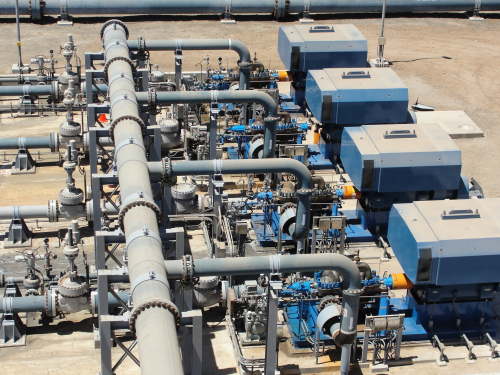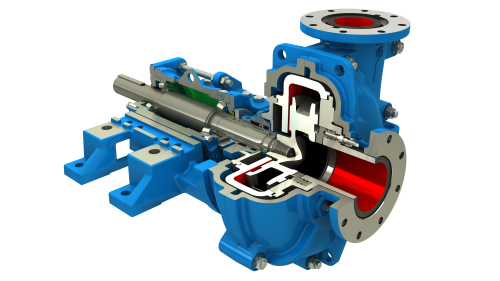

The oil and gas industry in Latin America is on an upward but uncertain growth trend. Earlier this year, experts at Fitch Ratings stated that Latin American oil and gas companies have strong cash holdings and are helped by higher oil prices. “[Oil and gas] ¬companies are positioned favorably to withstand difficult market conditions over the next 12 months,” it said. However, Fitch analysts added, “Rising fixed costs including escalation in labor and energy costs will cause a rise in production expenses.”
Reports like these highlight the pressure in natural-resource industries to lower production costs in order to achieve growth potential. In oil and gas refining, along with mining operations, managers are faced with a twofold challenge: Trim production costs while improving the control of the process. Advancements in traditional as well as digital pumping technologies can help, by improving energy efficiency and equipment ¬reliability at the same time.
It’s important to understand that these goals are closely linked, because any excess energy in a pump converts to heat or vibration that reduces reliability. That’s a simple fact of physics, but the direct relationship between energy efficiency and reliability of a pump — with the associated potential for double cost savings — is not well understood. Reducing energy waste in pumps can also boost process control, which is especially valuable for the pump-intensive processes that refine natural resources into usable products.
Smarter pumping at refineries To their credit, companies in the oil and gas industry were early adopters of automated process control systems that monitor production processes and optimize efficiency. In addition, the evolution of API standards has helped to ensure that process pumps are properly sized and designed. These and other trends have helped oil and gas producers to continually improve production, productivity and profitability.
At most refining operations, however, hundreds or thousands of pumps work outside the automated process control system — operating around the clock at full speed, with flows adjusted by manual valve throttling that lowers pump and process reliability.
Recent advances in pump hardware and accompanying software — commonly known as smart pumping — help plants across many industries to achieve the “trifecta” of lower energy costs, higher equipment reliability and improved process efficiency. Variable-frequency drives, which adjust the pump’s motor speed to meet the flow needs of the process, are the centerpiece of most smart pumping solutions.
However, the oil and gas industry has not been as quick to embrace VFDs as some other industries. This isn’t because energy efficiency is less important to energy producers. More likely, it’s because early VFD designs did not work well in typical oil and gas applications. Most refineries are sprawling, outdoor plants in remote locations where temperatures can be extreme, and access to specialized equipment and personnel can be costly if things go wrong. In addition, the need for smarter pumping was less evident, because of the general efficiency and reliability benefits of API standards.
Changing perceptions Recently, however, we have seen increased adoption of VFD technology in oil refining and gas processing operations worldwide. At the Volpak fuel terminal in Callao, Peru, operators faced the challenge of pumping ethanol to 10 distribution points, where all the control valves opened and closed at different times. By integrating ITT Goulds Pumps PumpSmart controls into their systems, engineers at the terminal were able to automatically stage each pump in the system to accommodate individual on and off times according to need. When a pump starts to run dry, PumpSmart controls engage to shut it down and protect it from damage. Even over short periods of time, operations that use smart VFD controls can reduce pump downtime and repairs, and save money through lower energy use.
The trend reflects a recognition that smart pumping technology, like the smart phone in your pocket, has improved dramatically in recent years.
• High reliability. A typical mean time between failures (MTBF) rate for today’s VFDs is more than 10 years, a dramatic improvement over early models.
• No piping modifications. Piping changes are seldom required to install modern VFD units, other than closing bypass lines that are no longer needed.
• Low voltage. The perception that pumps over 200 HP generally require medium-voltage VFDs with special wiring and power requirements is outdated. In fact, today’s low-voltage VFDs can be used for pumps up to 800 HP and placed in the field vs. in an ¬air-conditioned room.
• Smaller pump sizes. This does not reflect a technology advancement in VFDs, just a fact of system design. With variable speed controls, smaller pumps can be sized for bigger jobs, which lowers initial capital investment and energy costs over time.
• Quick payback. While some people expect a return on investment of five to 10 years, our experience is that today’s VFDs pay for themselves in six months to two years.• We do not suggest that every pump in a refinery should be controlled using VFDs. Many refinery managers use ¬smart-pumping technology first to improve reliability of “bad actor” pumps that generate high maintenance and repair costs. After integrating the ¬technology to solve these problems, it becomes easier to evaluate and justify the benefits of adding VFDs to other large or mission-critical pumps that also can offer a quick payback.
Less downtimeIn mine operations, like oil and gas production facilities, every minute of process downtime represents lost revenue. Mineral processing also tends to take place in remote outdoor locations where access to specialized equipment and personnel can be costly. That requires mine managers to place a premium on equipment reliability, and to keep their machines running with the resources they have available on-site.Smart pumping solutions are becoming more common at mine locations as one way to increase reliability and lower production costs. But most mineral production facilities, unlike oil and gas refineries, also process heavy slurries to separate valuable metals and minerals from surrounding waste or tailings. The abrasive qualities of slurries demand specialized, heavy-duty pumps and valves. Traditionally, slurry pumps require regular downtime for servicing as part of the cost of doing business. But a recent advancement in slurry pumping is changing that.
The Goulds XHD Extra Heavy Duty Lined Slurry Pump is designed to be maintained even while running, and to require less downtime for service procedures — with parts that are more accessible and adjustable than other slurry pumps.
The pump’s short bearing housing is easily adaptable to nearly any existing foundation, so operators can retrofit existing pumps without investing in costly refitting of pipes, electrical lines and concrete base structures. Designed to work optimally on both Service Class III (heavy) and Class IV (very heavy) slurries as defined by the Hydraulic Institute, these are some design highlights of the XHD pump:Adjustable suction seal ring. This unique feature can be adjusted — even while the pump is running — to compensate for wear and maintain optimum impeller clearance for peak performance. By maintaining proper clearance, users get longer wear life — not just for the impeller, but for the entire liquid end of the pump.
Replaceable wet end cartridge. The wet end of the XHD pump is designed as a replaceable cartridge, which allows operators to change parts more quickly and efficiently. To help the process, the XHD pump is built with a unique, tapered impeller shaft thread to aid removal, and for faster replacement of the impeller, with assurance that the shaft and bearing cartridge are properly aligned when the pump is reassembled.
Split stuffing box. The XHD pump’s open seal chamber utilizes a removable split stuffing box and gland for easier packing maintenance. Operators can choose their packing arrangement with dedicated seal water ports, and the stuffing box is designed to accommodate most mechanical seals by simply removing the split stuffing box.
Onboard condition monitoring. To help identify problems, XHD pumps are outfitted with i-ALERT monitors that measure vibration and temperature — a standard feature on process pumps from ITT Goulds Pumps. When an i ALERT monitor detects that pre-set limits have been exceeded, it signals users with a blinking red LED. The light is easy to spot, especially in mining applications where direct access to pumps can be a ¬challenge. It allows the pump operator to make changes to the process or the pump before a catastrophic failure occurs.
Heavy duty bearing cartridge. Mounted on fully protected machined rails that provide positive alignment and are easy to re-establish fit should wear occur, unlike saddle mounted bearing cartridges. Also, the wet end cartridge design enables the bearing cartridge to be removed and serviced without disturbing the suction, discharge piping or wet end of the pump.
Large-diameter shaft. The shaft on the XHD pump is manufactured for low deflection and longer seal life. Pump wear also is improved through heavy-duty bearings, standard oil lubrication (a grease option is available) and Inpro bearing isolators.
Dual impeller adjustment. A patented dual adjustment on the power end provides easy access for operators who perform impeller corrections. As operators see a drop in efficiency, they can adjust the impeller and/or seal ring, or replace the parts.
In the same way that improved extraction and crushing methods have boosted mine output over the years, these advancements in slurry pumping can help mines to improve productivity at costs that can be quickly recovered.
ConclusionDemand for natural resources will continue to grow, almost indefinitely, as developing economies advance and the world’s population increases. But that does not make life easy for the managers in charge of mining operations or oil and gas production facilities. In the global economy, managers in every industry face intense pressure to lower production costs while improving productivity.
Because the basic look of pump exteriors hasn’t changed much over the years, it’s easy to overlook the technology advancements in pumps that can help to achieve these goals. Pumps are especially critical to the industries that process natural resources, and therefore can play an especially important role in controlling costs. Smart pumping solutions, which improve the operating efficiency of a specific piece of equipment, can deliver a “trifecta” benefit to the operation as a whole — lower energy costs, higher reliability and improved process efficiency. In mining operations, advancements in the design of slurry pumps can also improve reliability and reduce downtime.
Wise investments in these technologies can deliver improved productivity and cost savings that go directly to the bottom line.
ContactMiguel Otarola, regional director, ITT Industrial Process in Latin America Buddy Morris, global product manager ITT Goulds Pumps ITT Goulds Pumps inquiries: ip.communications@itt.com





